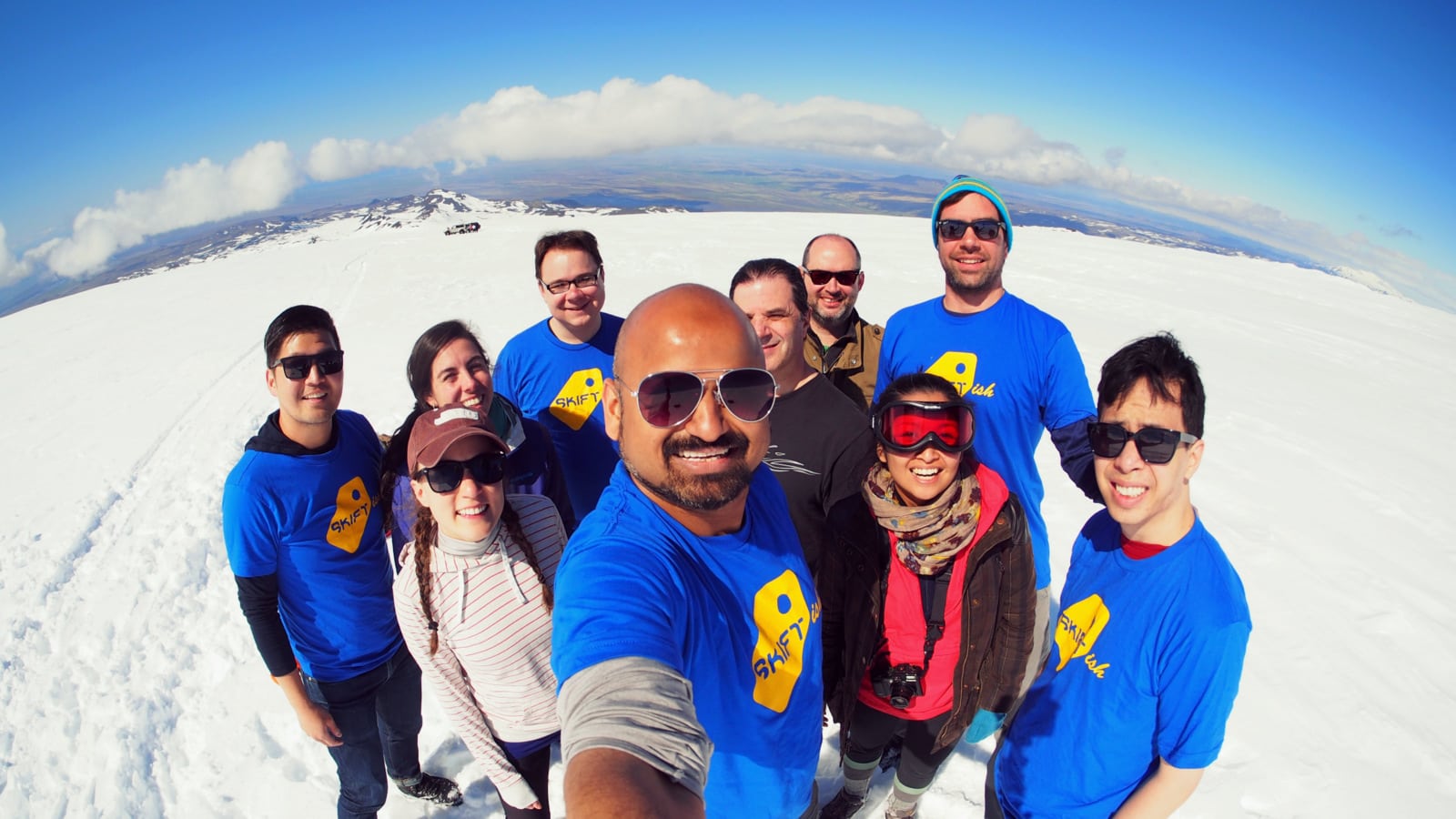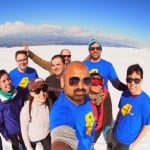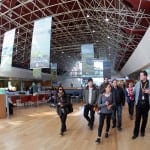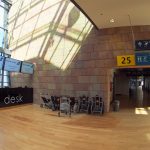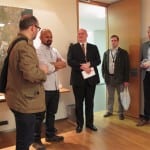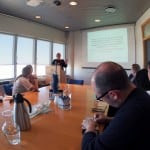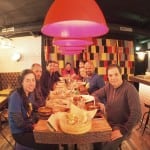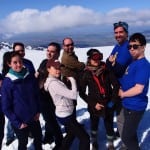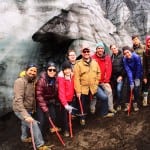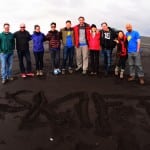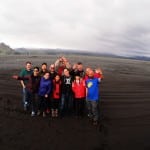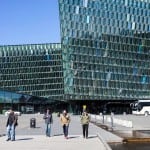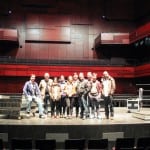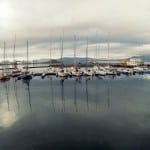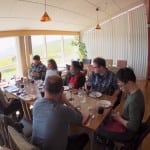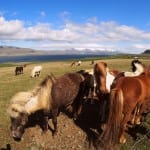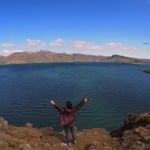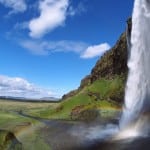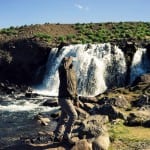Skift Take
Living and learning about the global megatrends we write about daily on Skift -- that was the main reason why we went to Iceland. It is the perfect crucible for a crash course in the changing global business of leisure travel.
- In our mind, this is the most iconic image of our Iceland trip, with the full team on top of the Eyjafjallajökull volcano in south Iceland.
- Skift Team getting behind-the-scenes tour of main Keflavik airport.
- The bright new service desk and clear wayfinding at Keflavik airport.
- Meeting Björn Óli Hauksson, CEO of Isavia, the main airport operating in Iceland, and talking business.
- Meeting the team at Promote Iceland and listening to a presentation about marketing the country.
- Our stay at the cool Loft Hostel, where the lobby serves as a meeting point of locals and tourists alike.
- Our lunch at K-Bar, a Brooklynization-of-the-world restaurant in Reykjavik.
- Climbing the deep snow for hours and hours, on the way to the top of the volcano in muscled out Superjeeps.
- These Superjeeps are super serious and super fun. We lucked out big time on the weather front too!
- In which we decided to do “Awkward Travel Trade Magazine Editor Photo Poses”, while out on the volcano in Iceland.
- Climbing the melting Vatnajökull glacier, getting a first hand lesson in climate change and how it is affecting the world’s glaciers.
- The Skift team near one of the caves in the Vatnajökull glacier in Iceland during a company retreat in 2014.
- On the black sand beaches of South Iceland.
- The tour drivers/guides were incredibly well versed and trained, and it made the whole experience that much better for us.
- Visiting the amazing Harpa convention and cultural center in Reykjavik.
- Designed in part by famous Danish-Icelandic artist Olafur Eliasson, Harpa has become a tourist destination beyond its events.
- The full Skift team, on stage at the main giant concert hall at Harpa.
- Gorgeous views of the Reykjavik harbor, from inside the Harpa Center.
- The serious business of discussing the future of Skift, at the Hlemmur Square lounge area.
- The Skift team lunch at the luxury Glymur cottages inside the Hvalfjörður fjord in West Iceland.
- The famous Hallgrímskirkja church in the middle of Reykjavik, the most iconic landmark in a flat city.
- Of course, we had to go visit the photogenic Iceland horses!
- We may or may not have lost a team member in a fjord in Iceland, we can neither confirm nor deny.
- The famous Seljalandsfoss waterfall in south Iceland, with a rainbow inside it!
- Most refreshing thing you’ll ever do in your life: drinking directly from Icelandic firehose, so to speak.
Or why Skift went to Iceland.
Skift is coming up on being two years old in a couple of months. With our team 10 strong now, we went on a rather unusual company offsite, our first ever: Iceland. As startups go, that was probably among the coolest destinations any early stage startup has ever been to, and there were a few reasons why we did it, in addition to the obvious team-building part of it.
One, we’re Skift, we’re the ones who report on global travel trends (see here, here, here and here, for example), and for us, our first company offsite had to be a cool destination which few other companies as a group had been to.
Second, attracting talent as we grow is a hard and full-time task in a very competitive startup city like New York, and our Iceland trip is indicative of the intense-but-fun culture we’re building into the company. We wanted the world to see it play out live, primarily in social media.
But the more interesting reason was to learn about the changing global business of travel. Iceland is the perfect crucible of a lot of global travel trends we cover on a daily basis on Skift, converging in the tiny country in so many ways over the last few years.
I went to Iceland in 2010, a week after the famous Eyjafjallajökull volcano fully stopped, then again in 2012, and now went back in 2014, so I have seen the changes in the country first hand. No one else in our team has, even though we have covered these changes since Skift’s start in 2012.
The less obvious part was the larger global travel trends playing out in country where for the first time in its history, tourism is now officially the biggest foreign exchange earner, surpassing its traditional industry of fisheries and aluminium production. Also the first time for in its history, Iceland will likely cross 1 million foreign tourists in 2014 — more than three times its tiny population of about 320,000 — growing at a crazy rate of about 20 percent per years for the last three years, and likely higher this year.
We wanted the team to see those changes play out in person, and we got plenty:
- Using digital tools to create a whole new image of a destination: We met the team at Promote Iceland, including its director of tourism Igna Hlin Palsdottir and heard about how it took the publicity surrounding the 2008 financial crisis and the volcano eruption in 2010, and went about using them to retool their whole economy around tourism. Using a smart mix of online, video and social media — through its equally smart Inspired By Iceland campaign — it has marketed the destination in ways big and small. Visuals, the new language of marketing in travel, works amazingly well for the otherworldly vistas of Iceland, and the country’s tourism marketing has used them smartly across digital channels.
- Using films as an effective way to brand a destination: We also heard from the Promote Iceland team about how it has methodically gone about attracting Hollywood production into Iceland, with movies such as Prometheus and The Secret Life of Walter Mitty, and parlayed that into brand recognition and promotion in ways few other medium can.
- Airports as destinations: We went and met the team at Iceland’s main gateway airport Keflavik International Airport, and got a great behind-the-scenes tour from Gudmundur Dadi Runarsson, the Deputy Terminal Director at the airport, along with his fabulous media team, and learned all the changes the airport is doing to make it the best representation of the country’s culture, both on arrivals and departures. We also learned about all the heavy incorporation of technology to make the passenger experience better, including rebuilding the arrivals baggage area from ground up, to better wayfinding and faster immigration lines. We also learned a lot about attracting retail, and creating the right shops to keep the passengers busy and spending.
- Airlines as a marketing extension of the country: Icelandair, the main national carrier, has become synonymous with the country, and has been very smart on two fronts: One, on starting the direct flights from key strategic points in North America and Europe, to bring in the hordes of tourists already predisposed to visiting due to brand awareness. Second, as soon as you board the flight, your Iceland experience begins, from the Icelandic water bottles, to the tours and activities you can buy on the flight.
- The rush for routes and effect of low-cost carriers: The onslaught of low-cost carries has arrived in Iceland and is in full swing, with Easyjet, Wizz Air and local startup airline Wow Air all now flying in and out of the country, and bringing the cheap Euro tourists by the thousands. Wow Air, the local airline which started last year, is now fighting with the Keflavik airport to get landing slots to start its low-cost flights from North America, and while they didn’t get the permission this year, they will likely get it next year. Flybe, the low cost European carrier, has just started “party flights” this summer from Birmingham into Keflavik at key times for the tourists to party all night — which really means bright light during summer in the country — in Reykjavik and then take them back, all possible within a day.
- The blurring of business and leisure travel: This has been a big marketing angle for Icelandair, which has pushed North American and European business flyers on trans-atlantic routes to add a few days of leisure in Iceland, at no extra cost and of course use the airline as a result. This speaks to the increasing trend of blurring of the lines business and leisure travel across various cultures around the world.
- The rise of affordable, local and smart design in hospitality: During our trip, we stayed at two hostels in Reykjavik, both of them very hip, embedded into the local culture, and with a savvy sense of modern design and user experience. The first hostel, Loft, has a lobby and a rooftop that serves as the venue for local events and even progressive political rallies! The second hostel we stayed at called Hlemmur Square, hosts regular Icelandic cultural events, including theater, in its lobby.
- Creating the right eclectic retail and food experience in the tourist district: Iceland has come a long way in its cuisine, infamous for its traditional sheep’s head, Rams testicles and cured shark meat and soup. The Scandinavian food movement is in full swing in Iceland, and various meat, fish and vegetarian options have ballooned in the last few years, including international cuisine options as well, key to keeping tourists from all parts of the world happy. Our best experience was at the K-Bar, a funky very Brooklynesque restaurant part of the equally funkily design OK Hotel, where the Asian-inspired food was incredible.
- The rise of experiential travel: This was a big part of our trip, the tours where we would mix adventure travel with the right team bonding experiences. The tours and activities sector in Iceland is booming, and you can see why big players like Grayline are moving in. There are hundreds of companies, mostly small, competing for the business, and offer everything from the very-touristy Golden Circle-type tours, to the deeper customized experiential tours. You can see the mainstreaming of adventure travel happening live, in Iceland.
- The rise of millennial travelers: This intersects with few other trends we saw in Iceland, including wanting deeper experiences as travelers. Iceland’s new “Share Your Secrets” campaign encourages locals to share their favorite Icelandic hidden places and experiences, with an eye towards millennial travelers demanding these experiences.
- The rise of Chinese travelers: This we saw first hand, in hotels and hostels we stayed at, as well as tour companies we interacted with and used. Even though it was early in the season, technically before summer season, there were enough buses filled with Chinese tourists to get a sense of their mass and increasing power of their numbers to change tourism economies. In hostels, we met the young indie Chinese travelers, the fast growing segment that will surely create big waves of changes in travel industry worldwide.
- The rise of sharing economy: Airbnb has arrived in Iceland in a big way. Booking.com shows a total of 705 organized hotels and hostels in Iceland, while Airbnb has 1000+ rentals available in the country, all illegal according to local Icelandic law. But the tourism authorities told us that the laws are going to change, to accommodate these inevitable changes.
- Pushing tourists beyond the gateway hub: Many European countries, UK, Australia and others are increasingly talking about moving tourists beyond the hub/gateway cities. In Iceland, where huge majority of tourists come through one airport/region, the challenges of pushing tourists beyond Reykjavik area and South Iceland are aplenty, and various regional tourism organizations are competing and trying, though there aren’t great answers yet. With the small size and its infrastructure, and all that the rest of the country has to offer, Iceland will have to come up with better ways — including better local flight options and maybe even developing Akureyri Airport in north as a bigger gateway — to move tourists around the country.
- Climate change and its effect on tourism: The north Atlantic and Arctic region is at the forefront of the effects of climate change, and we saw first hand how that is affecting Iceland and its tourism. One of the days, we walked across the rapidly melting and interminably sad-looking Vatnajökull glacier in South Iceland, and the our guide told us about how far out this glacier used to be, just a few years ago, and how they are wondering which glaciers will be left to show the tourists in a decade from now.
- Attract conferences into the country: Skift also visited the breathtaking new conference center and opera house Harpa, built to house various cultural events for locals and tourists, and more importantly attract meetings and conferences business into the country. Meet in Reykjavik, the local convention bureau, has been smartly marketing the city and country as a venue to “Let’s Meet in The Middle” of the North American and European routes.
- Creating sustainable tourism practices: Iceland is promoting itself as a green and fully energy independent destination, and it surely has the purest ingredients any country can dream of to market itself as a sustainable destination. But as it grows, how does it balance the needs of locals with the needs of the hordes of tourists? This will surely become a flash point sooner or later in a country where the tourist population by end of this year will be about three times the country’s tiny population and bound to rise even more. Iceland is expensive enough to attract a certain well-heeled subset of global travelers, but then low-cost airlines are creating a whole different kind of market and promoting Reykjavik a party city with its famed nightlife. Sooner or later, locals will empty out the center district if this continues to happen. This delicate and very difficult balance act is playing out in many popular destinations around the world, including Bali, Myanmar and others, and Iceland is going to go through it in the coming years.
Where should the Skift team go next year for its annual offsite, which other destination offers a great immersive learning experience a la Iceland? Let us know in comments below or email us.
The Daily Newsletter
Our daily coverage of the global travel industry. Written by editors and analysts from across Skift’s brands.
Have a confidential tip for Skift? Get in touch
Photo credit: The Skift team, on top of the Eyjafjallajökull volcano in Iceland. Photo by Rafat Ali
